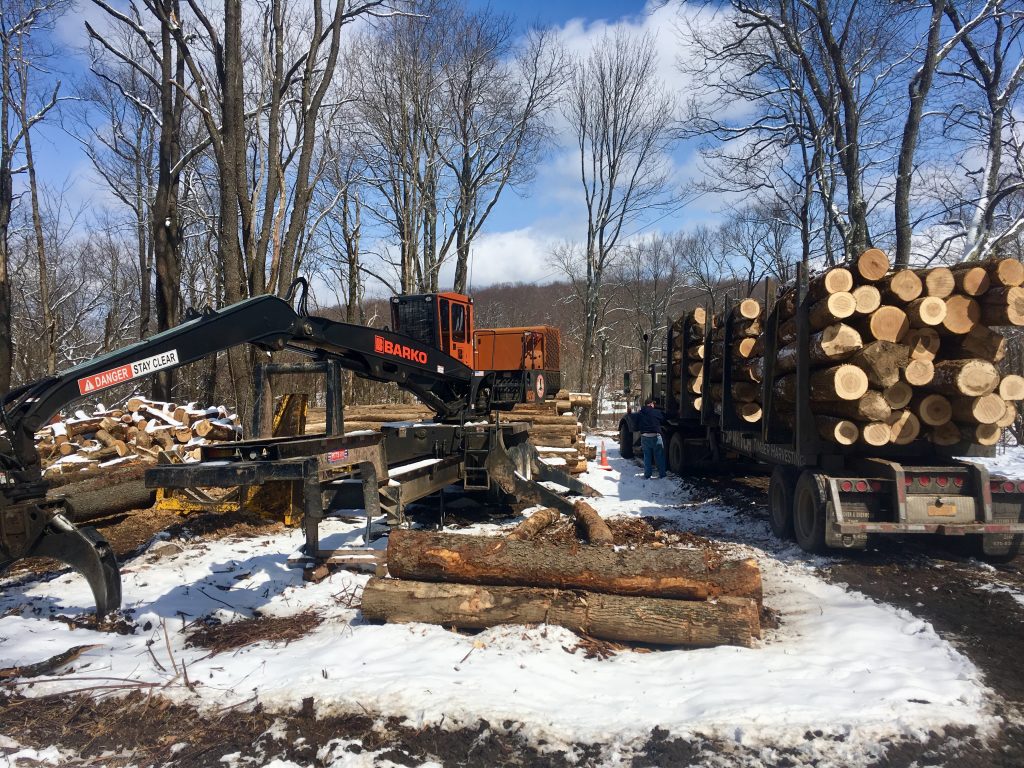In 2018, the Watershed Agricultural Council (WAC) launched its Forest Conservation Easement Program. “The goal of the Forest Conservation Easement Program is twofold,” stated Easement Program Director Ryan Naatz. “We aim to preserve large tracts of private forestland for both the water quality protection they provide and for the benefit of local industries that they serve. Our easements promote a working landscape, with timber harvesting as well as bluestone mining allowed in accordance to management plans that protect water quality.”
This program is already proving to be quite successful, as WAC recently closed on its largest project to date, over 1,000 acres of forestland. Ann Rasmussen and her family have owned and managed their lands in Walton, NY for timber production since the 1960’s. “This was a partnership that just made sense,” Rasmussen declared. “The goals of WAC and the Forest Conservation Easement Program closely align with our family’s goals. The easement allows us to continue to use the land for timber production, recreation and hunting as it has been for generations. Our partnership with WAC has helped us create a sustainable plan for the next generation to continue to work and enjoy the property as we have been fortunate to.”
 Ann’s family works with local forester Rod Jones of Northeast Timber Services to manage their forestlands. “WAC’s easement program is a great service to the local area. It keeps the land in timber production while also keeping it in private hands and on local tax rolls,” he noted. “I work with many landowners who have conservation easements. Sometimes families struggle to hold on to their lands as the expenses, planning and forethought needed can be significant. Conservation easements can be a great tool for helping families achieve their goals and be able to pass lands to the next generation. I’d much rather see the lands protected through working Forest Conservation Easements than the land be subdivided or sold to the City or the State, where it could be taken out of production.”
Ann’s family works with local forester Rod Jones of Northeast Timber Services to manage their forestlands. “WAC’s easement program is a great service to the local area. It keeps the land in timber production while also keeping it in private hands and on local tax rolls,” he noted. “I work with many landowners who have conservation easements. Sometimes families struggle to hold on to their lands as the expenses, planning and forethought needed can be significant. Conservation easements can be a great tool for helping families achieve their goals and be able to pass lands to the next generation. I’d much rather see the lands protected through working Forest Conservation Easements than the land be subdivided or sold to the City or the State, where it could be taken out of production.”Loggers, foresters and sawmills contribute approximately $8 million in annual timber sales to the economy in Delaware County, according to the Delaware County Agricultural & Farmland Protection Plan. Delaware is one of the five counties that make up the New York City Watershed along with portions of Sullivan, Ulster, Greene and Schoharie Counties. Statewide each 1,000 acres of forestland supports 3 forest-based manufacturing, forestry and logging jobs and 0.8 forest related-tourism and recreation jobs.
Since 2001 WAC has partnered with local farm families and landowners to conserve more than 28,000 acres of working agricultural lands throughout the NYC Watershed through its well-established Agricultural Conservation Easement program. Conservation easements are voluntary agreements through which landowners are compensated for the development rights on their land, agreeing to keep them in productive agricultural or forest use forever. WAC has conserved over 1,300 acres with their new Forest Conservation Easement program since its launch, with another 1,600 acres of projects expected to be completed in 2019, bringing the total conserved acreage of working lands by WAC to over 30,000.
The NYC Watershed is 78% forested and 60% privately owned, and provides over 1.2 billion gallons of drinking water to over 9.5 million people daily. WAC’s Conservation Easement Program is funded in partnership with the NYC Department of Environmental Protection (DEP), the agency charged with maintaining the City’s drinking water quality. The easement program came into fruition through the 2000 Filtration Avoidance Determination (FAD) which allowed the city to forgo costly filtration plants if they would fund upstream conservation measures.
The WAC Easement Program is now accepting applications for Conservation Easements. If you are interested in conserving your family’s forest or agricultural lands please contact the Easement Program at 607-865-7790 or click here for application materials.

